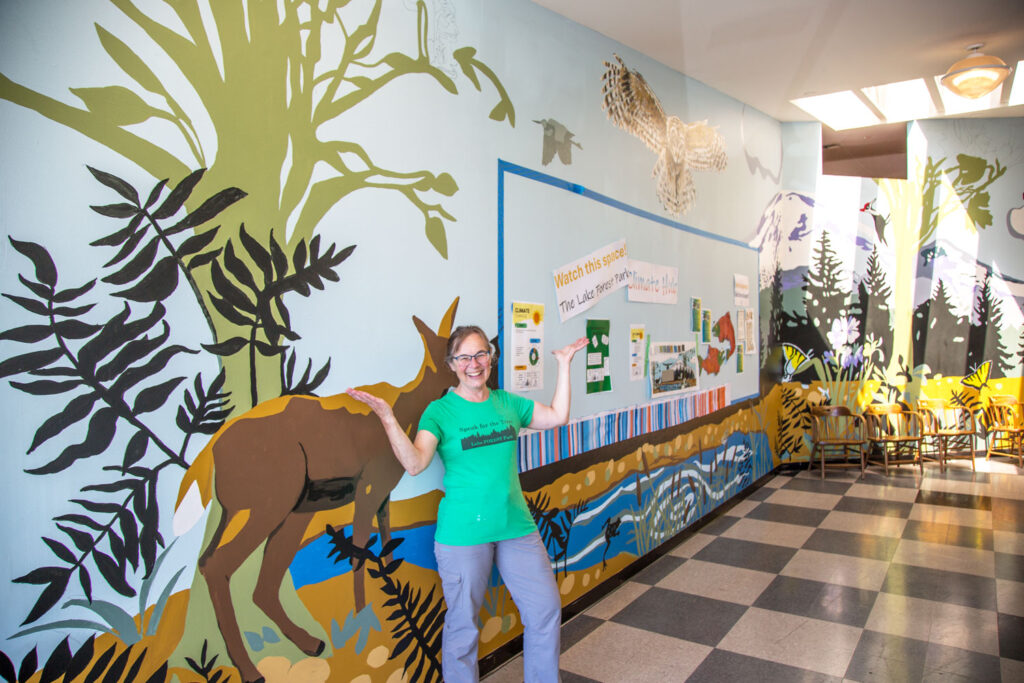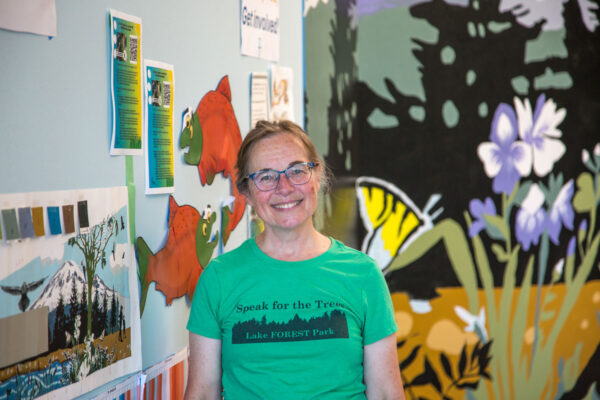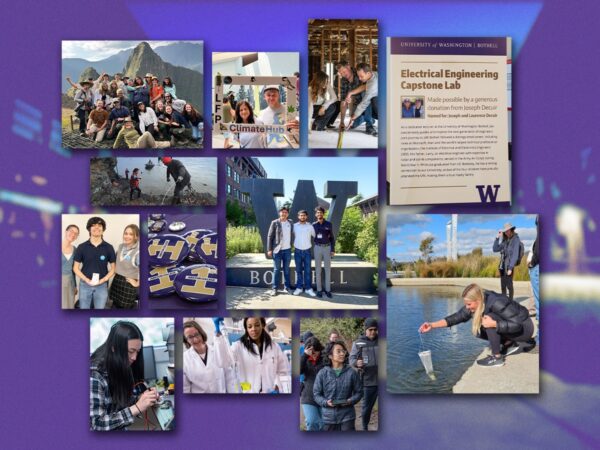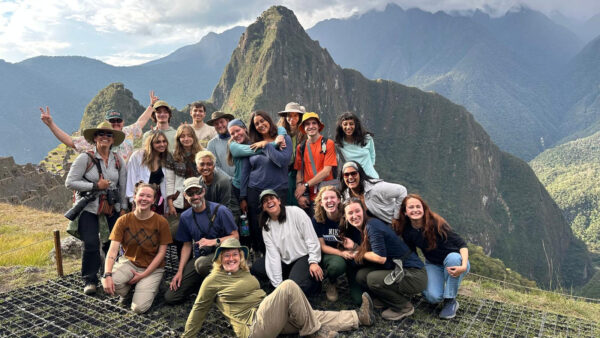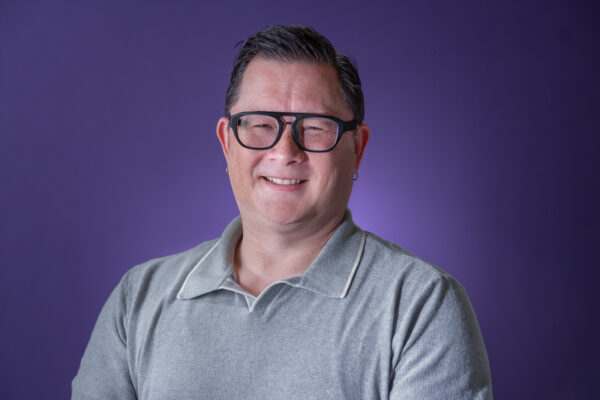When it comes to an issue like climate change, the sheer magnitude of the problem can, at times, be enough to make anyone feel hopeless. It’s tough to know where to even begin — especially when large-scale solutions fail to materialize or are set back because of politics or a priority of profits over people and the natural environment.
One of the best things you can do is focus on where you can make a difference, said Dr. Dana Campbell. And often, that starts with your own backyard or neighborhood.
“You don’t have to have any particular expertise or skill. You can jump right in and do a lot of stuff right in your own community,” said Campbell, a part-time lecturer at the University of Washington Bothell’s School of STEM. “Building activities and programs together as a community is a powerful tool for working on climate.
“We need more grassroots climate action.”
Hoping to inspire climate action in her own community of Lake Forest Park, Washington, Campbell imagined how a physical space could be used to bring people together to engage in climate work. Her vision became a reality this year in the form of the Lake Forest Park Climate Hub.
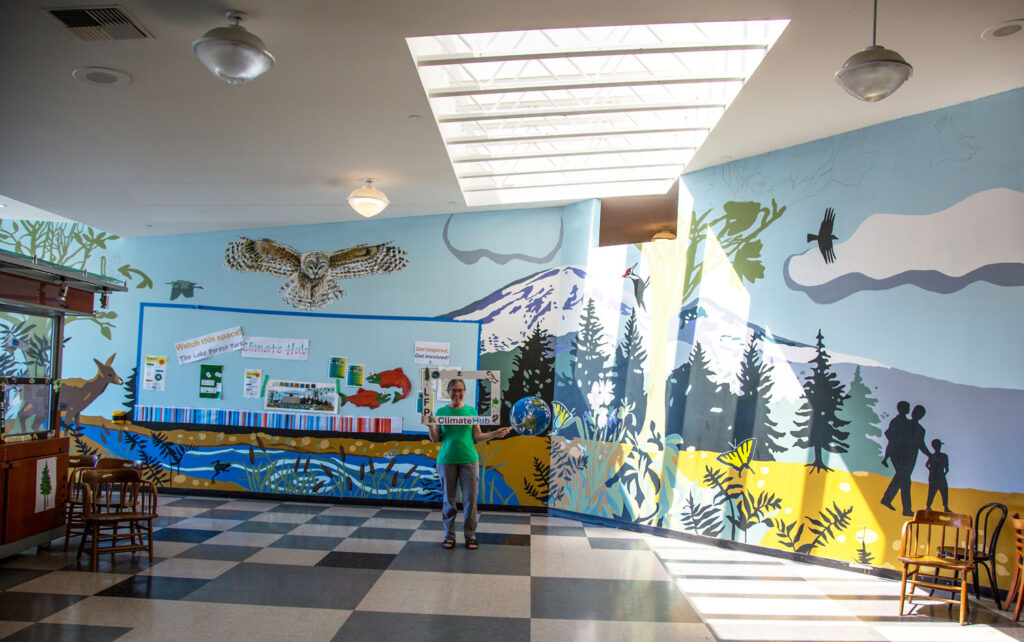
Getting involved
Campbell moved to Lake Forest Park in 2012 when her husband, fellow biologist Dr. Jeff Jensen, joined the STEM faculty — where he is currently a teaching professor. Before joining the faculty herself, Campbell focused on raising their two kids and enjoyed volunteering in their schools and engaging in community projects.
After her children left for college, she began looking for more ways to get involved. She discovered a network of neighbors who were immersed in local projects. One neighbor invited her to join the advisory committee for the Lake Forest Park Water District, and she accepted. Then, in 2022, when the local city council created the Climate Action Committee, she was eager to be a part of that as well.
Campbell’s interests as a research biologist are rooted in butterfly evolution, and she is involved in community science monitoring programs to support butterfly conservation. She is also passionate about climate change, and in addition to biology courses, she teaches “The Science and Narratives of Climate Change” as part of UW Bothell’s Discovery Core Experience.
“Building activities and programs together as a community is a powerful tool for working on climate. We need more grassroots climate action.”
Dr. Dana Campbell, lecturer, School of STEM
Her background and expertise made her a welcome addition to the Climate Action Committee, which was created to gather and analyze climate information to provide recommendations to Lake Forest Park’s city council. Community engagement to spread awareness about climate issues and connect people to resources and information also quickly became a mission for the committee — and for Campbell.
The committee often operated a booth at farmer’s markets and other events, but those opportunities were sporadic and could reach only a small portion of the community, Campbell said. “I realized we needed to get the word out to more people, so I started thinking about how we could communicate with a larger audience and have more of a physical presence.”
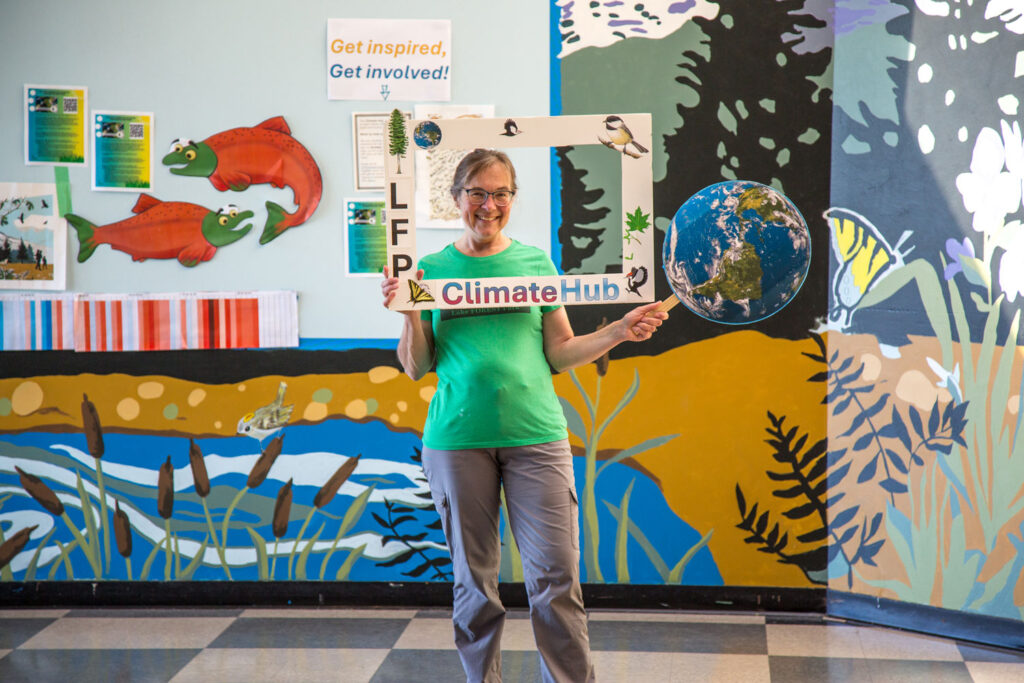
Creating a hub
Campbell was still chewing over ideas when she began a summer environmental education program — called Community Action Training School — through the local nonprofit Mid Sound Fisheries. There, her idea for a physical space began to take shape, and she presented “The Lake Forest Park Climate Hub” as her capstone project.
The hub, as she envisioned it, would be a place for people to go to for information on resources, events, opportunities to volunteer, community education and more. It would encompass a large bulletin space that could be divided into sections to highlight various organizations, provide tips for homeowners — such as how to create a rain garden or get a tax credit for a heat pump — and incorporate visual elements to spread awareness, such as the warming stripes (or climate stripes) that show the increasing annual temperatures over time.
“Lake Forest Park has a lot of volunteer organizations and individuals who are doing great work on climate and the environment, but it’s really kind of under the cover of darkness,” Campbell said. “The hub is a way to bring the work into the light, get people involved and offer resources for them to use in their own homes.”
Campbell shared her idea with the Climate Action Committee chair, Sarah Phillips, who eagerly jumped on board to help make it happen.
“Dana’s excitement about the project is contagious,” Phillips said. “With the federal withdrawal from action on climate change, local communities, counties and states have to pick up more of the work. The Climate Action Committee has three goals: to reduce emissions, protect and sustain the environment, and become a resilient community. The Climate Hub can be a piece of how this happens.”
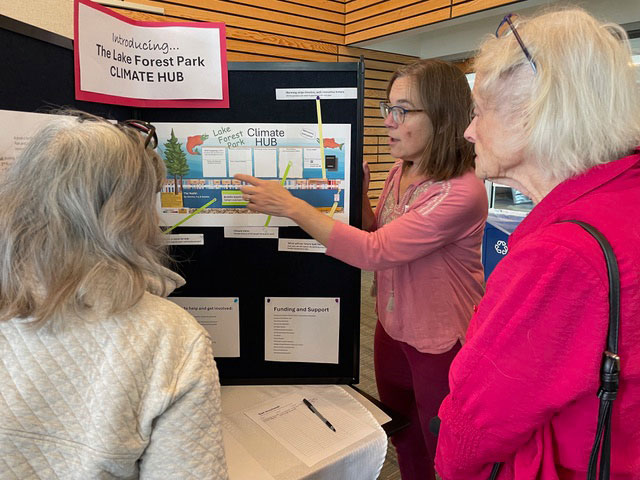
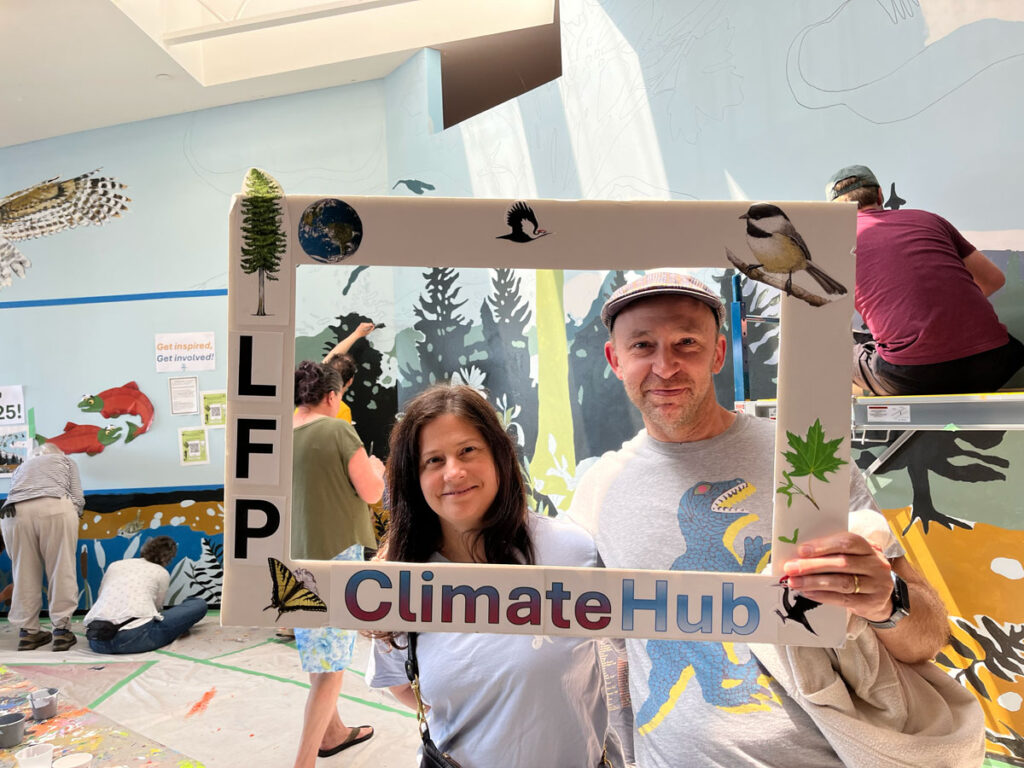
Finding a third place
When looking for the perfect location for the hub, there seemed no better fit than the Third Place Commons. Initially part of Third Place Books, the Commons is located in the Town Center at Lake Forest Park. Both the bookstore and the Commons are named for the ethos of the “third place,” as it was coined by the sociologist Ray Oldenburg, who wrote about the need for social gathering spaces outside of the work and the home — hence, a third place.
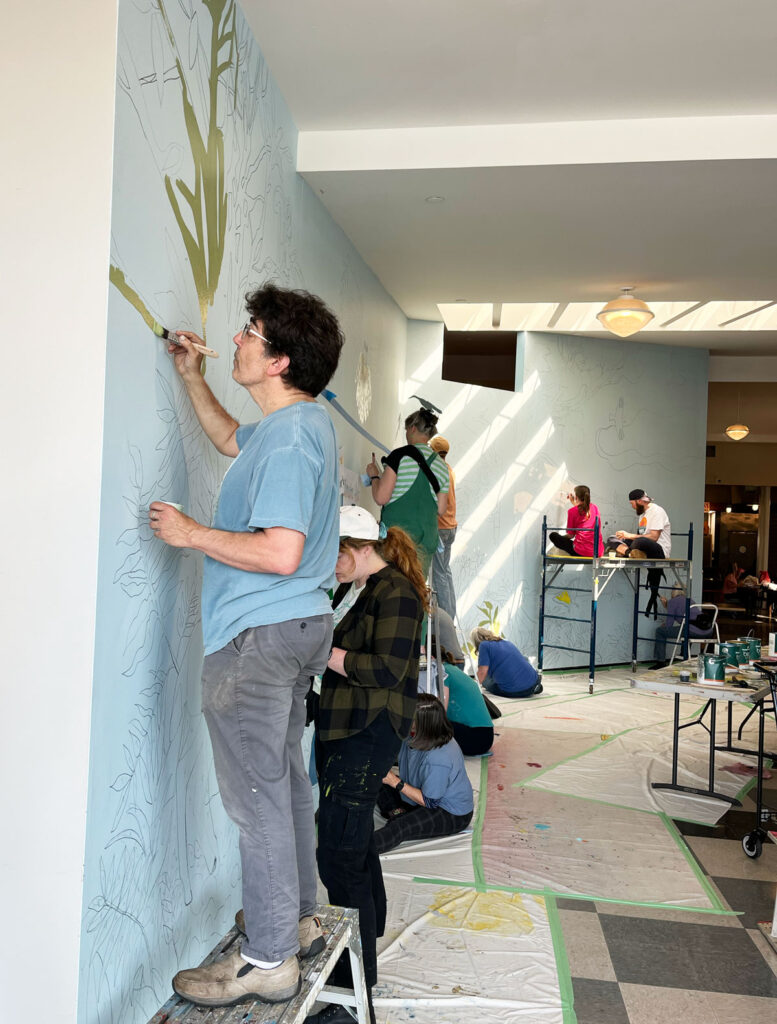
Today, the Commons is its own nonprofit entity that hosts hundreds of free community events each year. Campbell approached Merlone Geier, corporate owners of the LFP Town Center complex, about creating a hub consisting of an engaging mural surrounding a large central bulletin board. They gave permission to construct it along a 40-foot wall, with one caveat: that they approved the mural design. At this point, Campbell and Phillips brought in local artists Debbie Tomassi and Staci Adman to design and facilitate painting of the mural. Merlone Geier immediately approved the beautiful representation of LFP’s natural environments and gave the go ahead.
“The mural is like a magnet that draws people into the project,” Phillips said.
In late spring 2025, the designs were complete and the mural was painted by volunteers. More than 100 children, adults and senior citizens contributed to the painting, including several UW Bothell faculty and students.
While the final touches are still being put on the bulletin board and the mural, the project has already received a lot of community interest, Campbell said. And when she passes through, she’s excited to see people gazing at the mural or reading the few items that have already been posted.
Planning a better future
When she looks at the Climate Hub today, Campbell is proud to see her vision brought to life. The gears in her mind keep turning, however, as she imagines all the possibilities for the hub.
This, she noted, is just the beginning. Her goals for the future of the hub include a touch screen display with interactive resources, such as GIS maps with educational layers of information, as well as a suite of educational resources for teachers. She is now pursuing this, along with Sarah Phillips and Dr. Miriam Bertram, assistant director of the UW Seattle Program on Climate Change, through a grant they just received from Thriving Earth, a program of the American Geophysical Union.
“Dana is an accelerator,” Phillips said. “She can’t stop thinking about what else could happen and is already thinking about next steps and ways to get people involved.”
Campbell said she also hopes the hub will serve as a catalyst for similar projects in other communities that could work together as a climate network — bolstering the resilience and capacity of individual communities.
In many ways, the hub has already begun to serve its purpose by bringing together so many people who helped make it happen, she added.
“I think about how lucky I am every day to live here and be part of a community that really cares,” Campbell said. “And not only cares but wants to get involved and be engaged. It makes you feel so much better to have people there who enjoy doing this kind of thing together.”
